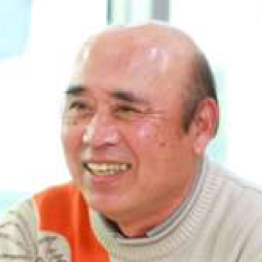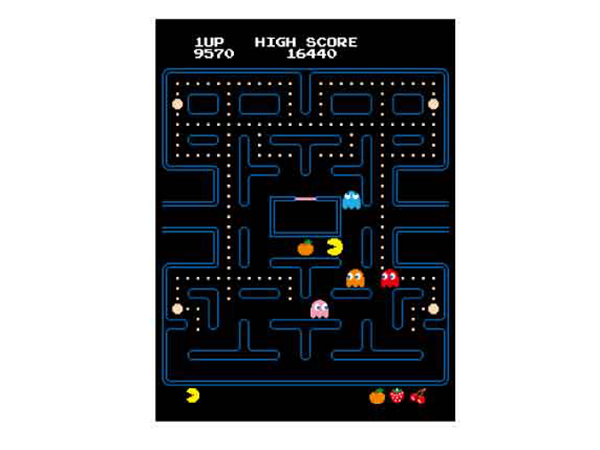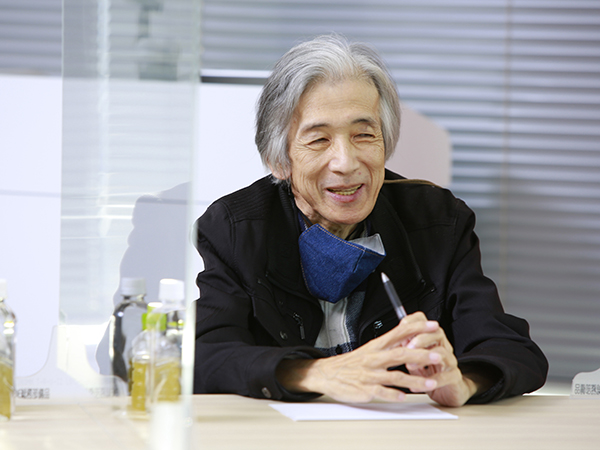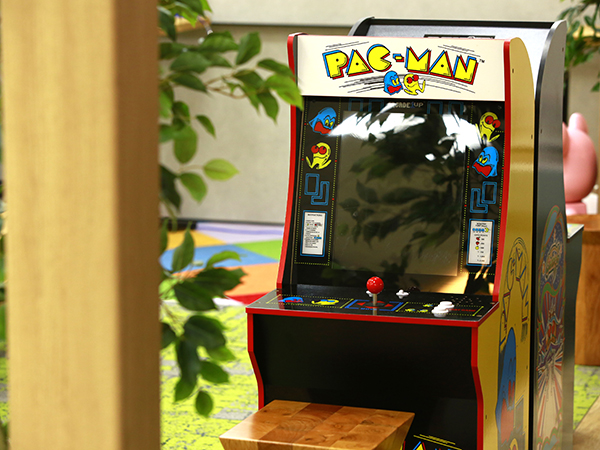PAC-MAN has been a beloved franchise worldwide since its launch in 1980, and this year it celebrates its 40th anniversary. Asobimotto took this opportunity to gather some of the key figures who worked on the original game for a 3-part look at PAC-MAN’s history.
*This article was originally released in Japan on January 26, 2021.
Here in Part 1, we take a look at some previously untold stories about the game’s development and production, as well as discuss the state of gaming back in the 1980s. In Parts 1 and 2 we cover our talks with game designer Toru Iwatani and others who worked on PAC-MAN.

Toru Iwatani
Planning & Game Design

Toshio Kai
Sound Design (Game start music, coffee break cutscene music)
Mr. Kai joined the Nakamura Manufacturing Company in 1970. He worked not only on 30test and other arcade machines, but also produced music for Galaxian and PAC-MAN. Additionally, he worked on developing names for game titles until the mid-80s as well as designing the NAMCO logo.

Shigeichi Ishimura
Board Design
Mr. Ishimura joined the Nakamura Manufacturing Company in 1976. He worked on not only the arcade version of PAC-MAN, but also the Famicom releases of PAC-MAN and RIDGE RACER, and designed content for mobile phones starting in 1999; growing the mobile content market. Mr. Ishimura went on to become president and CEO of NAMCO in 2005.

Sho Osugi
Cabinet Design
Mr. Osugi joined the Nakamura Manufacturing Company in 1972. He was an expert cabinet designer who worked on a number of arcade games. Mr. Osugi designed cabinets for a number of NAMCO games in the 70s and 80s including FORMULA-X, SUBMARINE, PAC-MAN, Galaga, and FINAL LAP.

Tadashi Yamashita
Character Design (characters, logo font)
Mr. Yamashita joined the Nakamura Manufacturing Company in 1970. He worked on over 30 games including PAC-MAN and Galaxian (designing both logo and graphics). Mr. Yamashita is currently a committee member of Shinkyo Bijutsu Kyokai and is active as an artist.

Hiroshi Ono
Cabinet & Marquee Designer
Mr. Ono joined the design department in NAMCO’s development division in 1979. He worked on design and pixel art for over 80 games including PAC-MAN, Galaga, and XEVIOUS. Since 2016 he created works of pixel art under the name “Mr. Dotman,” exhibiting his pixel art and holding workshops.

Yoichi Haraguchi
Production (Semiconductor Procurement)
Mr. Haraguchi joined the Nakamura Manufacturing Company in 1973. He worked in the production division procuring semiconductors for games such as PAC-MAN and Libble Rabble.

Akiyoshi Sarukawa
Domestic Sales
Mr. Sarukawa joined the Nakamura Manufacturing Company in 1976. He was head of domestic sales for titles such as PAC-MAN, SUBMARINE, and XEVIOUS.

Katsutoshi Endo
Domestic Location Business Management
Mr. Endo joined the Nakamura Manufacturing Company (later NAMCO) in 1963. He worked as head of Domestic Location Business Management for games like PAC-MAN and XEVIOUS.
The Drive to Make Games for Everyone – The Era and Environment Which Brought About PAC-MAN

What was the video game industry like when PAC-MAN was in development around 1980?
Sarukawa: It’s been more than 40 years now, so I had to do a little research to jog my memory before coming here today, but in 1972 ATARI’s (*1) Pong became a hit and the Nakamura Manufacturing Company (later NAMCO) bought out ATARI Japan. Breakout then released in 1976, and later in 1978 NAMCO released its first original game, GEE BEE. Taito released SPACE INVADERS that same year, and video games really took off. Galaxian came out at the end of the following year in 1979, and PAC-MAN took the torch next in 1980.
Back in those early days, however, games would sell well for the first 1 or 2 months after they released, but fall off quickly after that. You’d often hear vendors talk about how video games just were not profitable.
*1 ATARI: US video game company founded in 1972. NAMCO bought out the Japanese-based branch, ATARI Japan, in 1974 and expanded into the games industry.
Haraguchi: Yeah, this perception might have changed a bit after Breakout became a hit, but until SPACE INVADERS took off, most vendors who bought our cabinets felt the same way.

Endo: From my perspective–working to secure locations for our games–block-breaking games took off after the success of Breakout, and the public’s familiarity with video games really grew once these were made into cocktail table arcade machines and started being set up in the over 130 thousand coffeehouses around the country at the time. At the peak of coffeehouse popularity, there were 165 thousand shops, and 35 thousand of those had video games installed.
It was a time when we were finding a larger variety of games and more styles of play.
Sarukawa: In 1977 NAMCO released its “ele-mecha” (*2) game SHOOT AWAY (*3), and it was really incredible. Customers would play while out drinking in Kabukicho (*4) and spend one or two thousand yen on a single play session. We also had NAMCO’s SUBMARINE (*5) right there alongside it. But until video games took over the market, the real kings of the arcades were pinball machines.
*2 Ele-mecha: Short for “electromechanical machine,” this name is used in Japan to refer to arcade machines which are not video games, medal games, or pinball machines, or more loosely all arcade games without monitors.
*3 SHOOT AWAY: A shooting game based off the sport of clay shooting. Rebooted as Shoot Away PRO in 2018.
*4 Kabukicho: An entertainment and red-light district in Shinjuku, Tokyo.
*5 SUBMARINE: A shooting game based on submarine warfare released in 1979.

Kai: I was really taken in by the variety of games offered back when ATARI started releasing pinball machines. I think a lot of people were trying to seek out what made games fun. Mr. Iwatani did lots of research into this himself when creating GEE BEE (*6). Then one day I received word that Iwatani was doing research on a strange sort of game. A game where the goal is to eat and run away.
*6 GEE BEE: NAMCO’s aforementioned first original video game. Released in 1978.

I take it, this was PAC-MAN?
Iwatani: The first game I worked on after joining NAMCO was GEE BEE, which took ideas from both pinball and block-breaking games. Mr. Osugi thought up the idea for the game and I worked on the design. But we ended up making the game a little too difficult, so although it sold well on release, these sales quickly plummeted. With PAC-MAN, I wanted to create a game that would not upset the player. My goal was to make a game that could be enjoyed by everyone, whether they were good at video games or not.

Ishimura: I think we were on our way home from having a few drinks out in Yokohama, right? Mr. Iwatani saw some girls really enjoying themselves at an arcade and I remember him saying “I want to make a game that does that for people.”
This desire to make a game anyone could have fun playing came together as PAC-MAN, a simple game that could be played with a single joystick with no buttons for attacks.
Iwatani: Right, I wanted to make a game that was not only easy to operate and understand, but one in which you did not kill enemies, either. During development the team felt the game lacked any real thrill, and there was some talk of adding buttons for attacks, but these ideas never made it into the final game. The core of the game did change throughout development, however. The maze layout from the planning stage is different than the one that made it into the game. It used to have dead-ends and no POWER PELLETs. The idea of shutters had been floated around too, but our programmer Shigeo Funaki shot that one down.
Essentially, we had all of these concepts and ideas, and worked to refine the gameplay, the design, and the controls to be as simple as possible. The end result was a game that seems to almost enter the realm of wabi-sabi and offers a sense of beauty through simplicity.
Bringing the Simplicity of Pop Art to Gaming – Stories from System and Character Development

The game’s graphics might be simple, but they evoke a sense of the brilliant American pop culture and pop art that influenced them.
Iwatani: A lot of work went into the neon light look of the stage background. We thought people would shy away from the idea of a maze, so we built it to look like thin blue neon lines to keep it from standing out and designed the background to be black so the stage would fade away into it.
I was a really big pinball fan, drawn to how cool the design of the glass and the game boards were, and I think this had a lot of influence on the graphic design that went into PAC-MAN. I think the fact that we have cherries as one of our Fruits (bonus items) shows some influence from slot machines, too.


So, an emphasis was put on making the game eye-catching and smart.
Iwatani: Nintendo’s Shigeru Miyamoto (*7) had really good things to say about the design of PAC-MAN.
*7 Shigeru Miyamoto: Creator of series such as Mario, The Legend of Zelda, and Donkey Kong.
Yamashita: In terms of character design, Mr. Iwatani came to me with what was seemingly a near-finished game. It all came together with just a simple yellow circle for PAC-MAN and 4 different colored ghosts. So, I worked on the design from there, quickly adding arms and legs to PAC-MAN’s circular body. The result was so simplistic that I felt it needed something to give it more character, so I added eyes reminiscent of a classic manga style. Oh, and by the way, the reason PAC-MAN has slits in his black eyes is because I designed his eyes to be an enlarged and elongated version of PAC-MAN’s design itself. No one seems to have noticed, but I think this not only gave him character, but gave the design some real impact.

Iwatani: Oh! Now I see it!
Yamashita: This might sound strange coming from me, since I designed him, but I sometimes even find myself comforted by PAC-MAN’s cheery, carefree look. He just looks like he doesn’t have a single thought on his mind. He’s a character whose presence can really cheer you up.
Iwatani: Mr. Yamashita really hit the nail on the head when he said that PAC-MAN is a simple character without a worry in the world. He’s also made to be one that eats absolutely anything. I mean, he’ll even eat a police officer’s pistol. That’s just the sort of character he is.
Yamashita: The logo was also designed with this feel for the character in mind, incorporating elements from old American animation.

Kai: We had been limited to just 4 or 5 colors in our palette up until that point, but as we entered a new era of game development, we were granted much more variation. Mr. Yamashita brought a new feel to the design of Galaxian (*8), and I think this carried over into the character design for PAC-MAN. Back then, we would read US entertainment magazines like Billboard and reference them during development.
*8 Galaxian: Video game released in 1979. NAMCO’s first shooting game.
Endo: That reminds me, back when we were doing location tests for Galaxian, we installed a cabinet on site at 4PM and by 10PM that same day it had been stolen. When I called our company president, Masaya Nakamura, I remember he told me, “If it’s good enough to get stolen, it’ll be a hit.” The confidence that game lent us probably carried over in part to PAC-MAN.

What was the draw of PAC-MAN for everyone back then?
Ono: The character design left quite the impression. I joined the company in 1979 while PAC-MAN was in development. Yamashita and I split up the work, with him drawing the character and me designing the cabinet title marquee and sides.
But when I tried to draw PAC-MAN the way that Yamashita did, I couldn’t get him to look quite the same. Yamashita says it was an easy character for him to design, but even his simple design is done with perfect curves and comes together with an incredibly polished look. I wasn’t involved with any pixel art until Galaga, so I wasn’t working to design the on-screen pixel characters at the time, but I remember wondering how they managed to make something so gorgeous. The ghosts especially stood out, and I learned a lot from how they used two patterns to make it appear to be moving around. They taught me lessons that stick with me to this day.

Yamashita: The ghosts are great because there are different versions of them, too.
Iwatani: Exactly. Mr. Funaki thought up a way to have the four ghosts, Shadow (BLINKY), Speedy (PINKY), Bashful (INKY), and Pokey (CLYDE) all move in different ways.
When PAC-MAN eats a POWER PELLET he flips the table on the ghosts and gets to eat them instead, but they don’t disappear once eaten, instead turning into a pair of eyes that return to the center box, regaining their ghost form and picking up the pursuit once again. This relationship between PAC-MAN and the ghosts was quite iconic.
Iwatani: See, they don’t get “eaten” per say, but instead are bitten before running off to safety. This idea comes from that concept of creating a game that would not upset anyone. PAC-MAN’s relation to the ghosts is akin to that of Tom and Jerry, an innocent, friendly sort of bout. I was heavily into manga and animation back then. When I was working on the ghosts, “Little Ghost Q-Taro (Obake no Qtaro)” was the first thing that sprang to mind. The idea of flipping the roles of PAC-MAN and the ghosts also came to me from the spinach used in Popeye. Almost all of my ideas back then drew from manga and animation this way.

Endo: Coming from the sales side, I remember thinking we had something that could compete with the popular titles from our competitors. I felt we had a game that could upend the industry. One that could make its home in the coffeehouses across the country
Osugi: It was probably the first game to add an interlude (coffee break) too, wasn’t it? I remember thinking that felt like a fresh new idea. I played plenty of PAC-MAN myself.
Iwatani: Mr. Funaki really pushed back against the idea of the coffee break sequences, asking why he should have to program something that is entirely unrelated to the gameplay, but I managed to talk him into it, explaining that these interludes would act as both a break and a goal for the player, and have a massive impact on sales of the game.

Bringing Ideas to Life – PAC-MAN Complete at Last!

Haraguchi: And Mr. Kai, you made the music, right?
Kai: Yeah. Mr. Iwatani was a fan of The Allman Brothers Band back then.
Iwatani: Don’t tell me…!!
Kai: I wanted to try and write music that fit that feel (southern US rock), but that led me to think of the feeling I get listening to the music having Romani atmosphere… such as Hungarian guitarist Gábor Szabó, so I drew inspiration from him. He’s a guitarist that even Carlos Santana is a fan of. I liked this song of his that was performed using only a single chord. For the most part, the music scene in Japan at the time heavily focused on melody, but with PAC-MAN I went with a one-two drum and hi-hat line with a chord added on top that I would alter slightly, taking it up or down a half-step.
Iwatani: This is the first time I’ve heard you say you used The Allman Brothers Band as a reference point, and I’m honestly touched. Thank you.
Tell us more about the board design next; if you could.
Ishimura: We had already made Galaxian by that point, so while the game was still in the planning stages, we reused hardware from that. Once we had an idea of the final design of the game, I designed an all-new circuit board for it. I kept the idea of mass-production in mind as I created it. Up until Galaxian the focus had simply been on getting the games running, so the design incorporated some parts which were difficult to come by, making them poor fits for mass production.

Haraguchi: Those were tough times. I was single-handedly in charge of semiconductor procurement, and some of our female colleagues would help out sometimes, but it was tough work. There were more than a few times when deliveries wouldn’t arrive on schedule, and we had to do whatever we could to get the parts we needed.
Ishimura: Learning from that experience, with PAC-MAN, our primary focus was to design boards that would be stable no matter who put them together. I think that left the game with far fewer issues that needed to be fixed or adjustments to be made.
What about the cabinet? How was that designed?
Osugi: I think we made something great with the joystick. It was both compact and durable. We used an uncommon self-aligning bearing on the part of the joystick that moves.
Sarukawa: That cross joystick was incredible.
Osugi: What I did the most research into was the positioning of the microswitch (used to move the joystick). Looking at the specs for the switch, the description was really vague, and said that even the slightest overload would reduce the life expectancy of the part to a few million uses, but with proper usage it would last tens of millions of uses. So, I designed it in a way to cause as little overload as possible. Thinking back on it later, though, I realize that we were dealing with such little electric current that it wouldn’t have been much of an issue to begin with. But I think the design we came up with then is still probably being used by other companies to this day.
So, the design was incredibly durable during development, but once we entered the production phase, I got a call from another section telling me there were piles of iron powder inside when they opened the cabinets. This was because someone had gone ahead and replaced the white grease resin (lubricating oil) I had added to the design to protect against wear with something else entirely. As for the overall cabinet design, we came up with something pretty versatile working on Galaxian, so we simply changed the artwork. The biggest issue was the title marquee. We must have used around 10 colors, right?

Ono: I don’t think we used that many.
Osugi: At any rate, we used silk-screen printing, so each color had to be individually applied and dried. So, if we had used, say, 10 colors, that would mean we had to go through this process 10 times.
Ono: I think we made the back of the cabinet marquee silver so you couldn’t see through it too, right?
Yamashita: Yeah, it was silver.
Ono: That meant we would use the whole board just for that. It was quite the process. Each of the parts came together as a result of all these laborious steps.
Can you tell us next about your on-site test?
Iwatani: Our test was in the game corner on the roof of Tokyu Bunka Kaikan, where Shibuya Hikarie stands today. The first one was on May 22nd, 1980. This spot was right on the course that movie goers from the theater were led through, and a location where everyone from young students to the elderly were present. It made for a location where we figured we could get an even mix of male and female players. I was there that day, trying to watch people as they played and take notes without being noticed. We ended up getting just the results we were hoping for, with women excitedly playing and couples having fun while they played. It felt like we had really met the concept we were shooting for.
So, in other words, you truly brought your ideas for the game to life?
Iwatani: We did. I was most worried about the difficulty level, but plenty of non-gamers, just people from the general public, still got into the game for the most part and seemed to enjoy themselves. I remember how thrilled I was to see it all with my own eyes.

*Details from the interview are current as-of early November 2020.
*Participants removed their masks only for photographs.
Editor’s Note
PAC-MAN was born in an era when video games were gaining popularity. Here in Part 1 of our interview we heard from the creators about the troubles and processes they went through in bringing the game to completion. In Part 2 we cover PAC-MAN’s growing popularity post-release and talk about the state of the games industry at the time. Be sure not to miss it!
Jin Sugiyama
Freelance writer & editor. More fond of entertainment than just about anything.
▼Read Part 2 of the article





Mr. Iwatani joined the Nakamura Manufacturing Company (which would later become NAMCO) in 1977. He designed games such as GEE BEE and Bomb Bee in addition to PAC-MAN. Mr. Iwatani currently works as Professor Emeritus at Tokyo Polytechnic University.